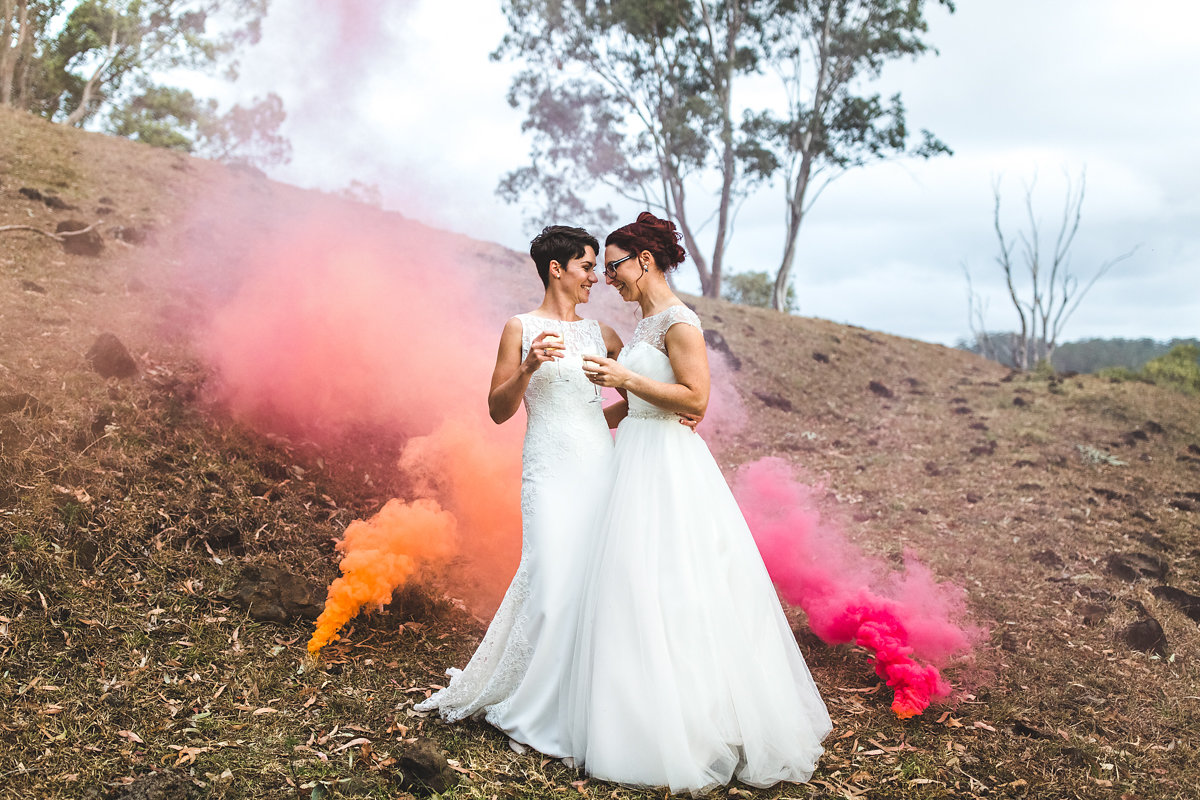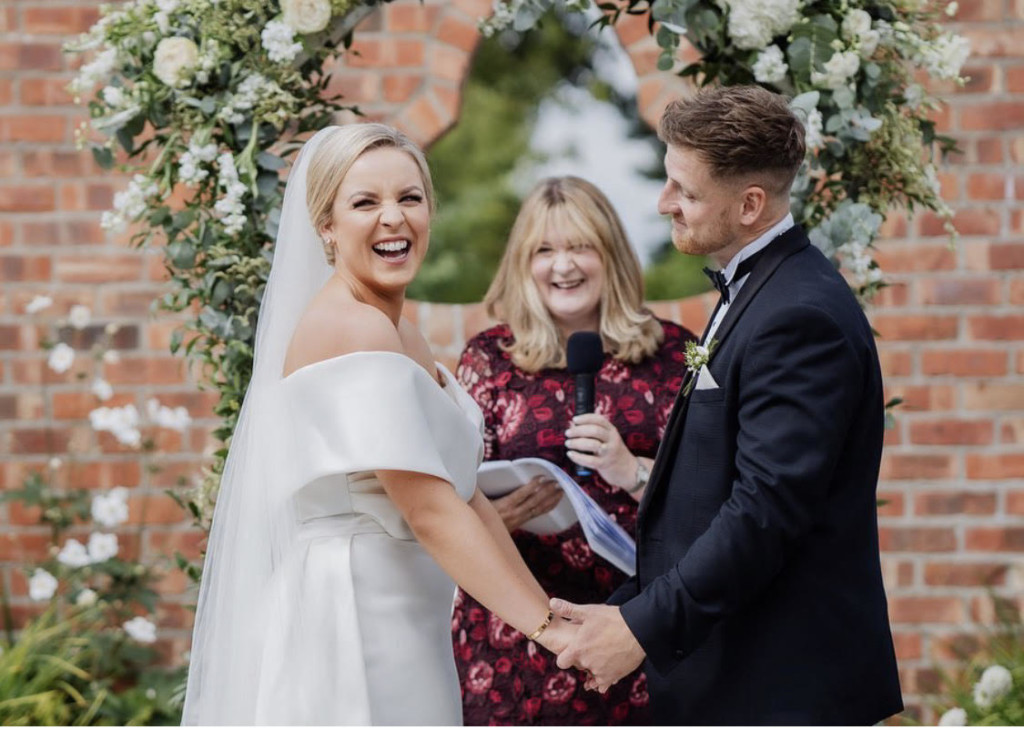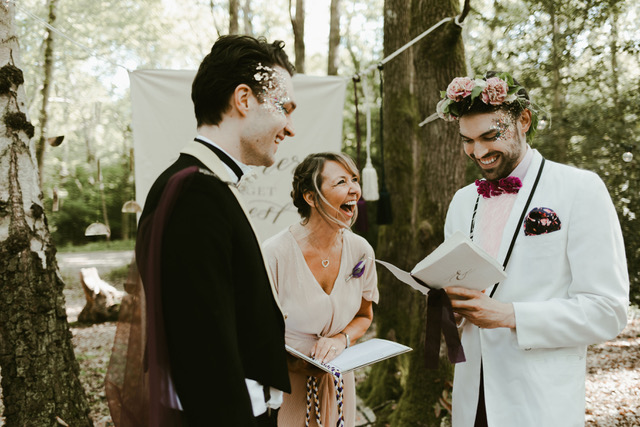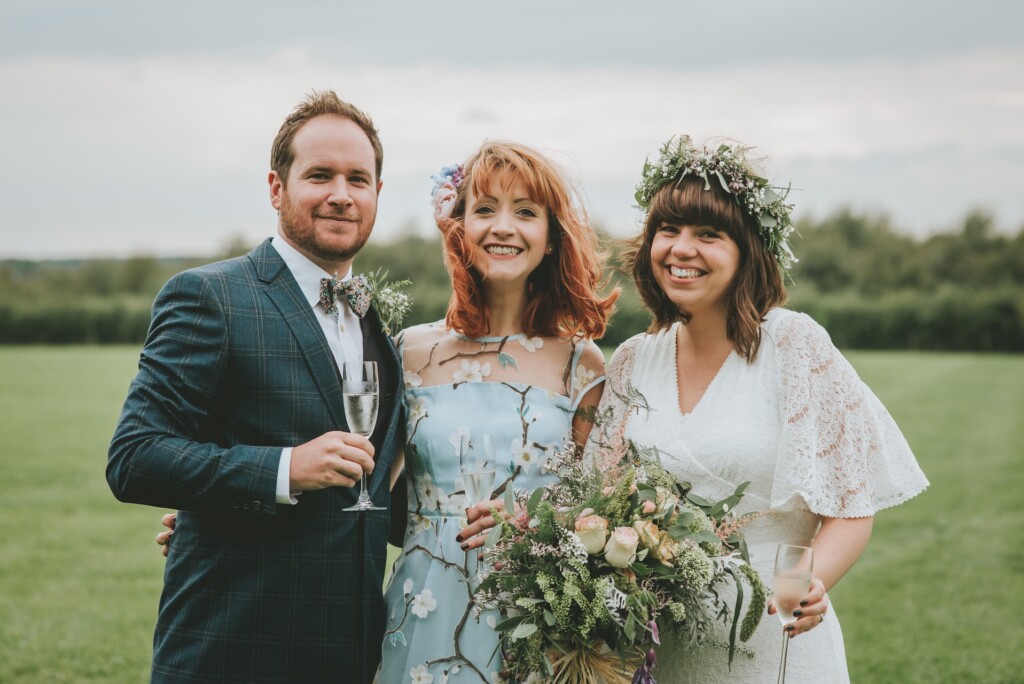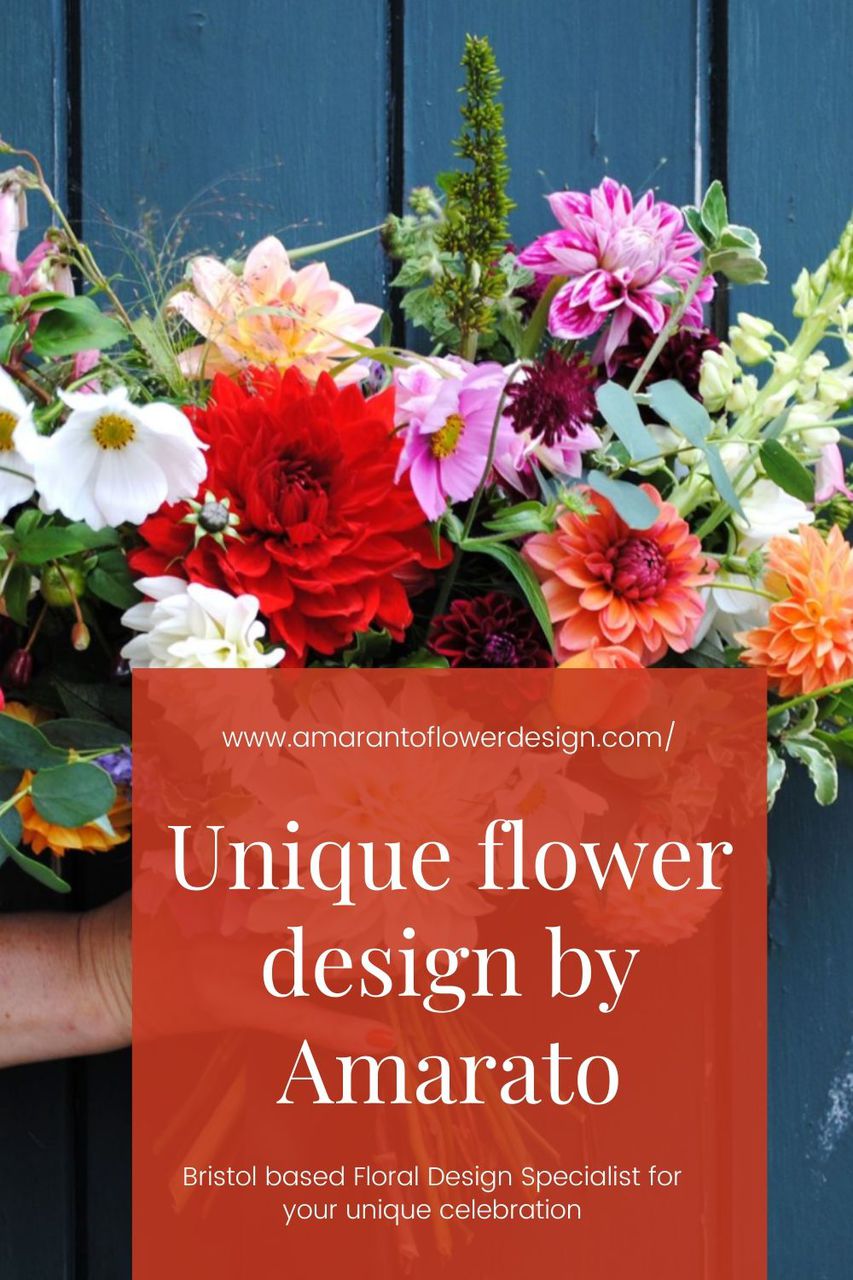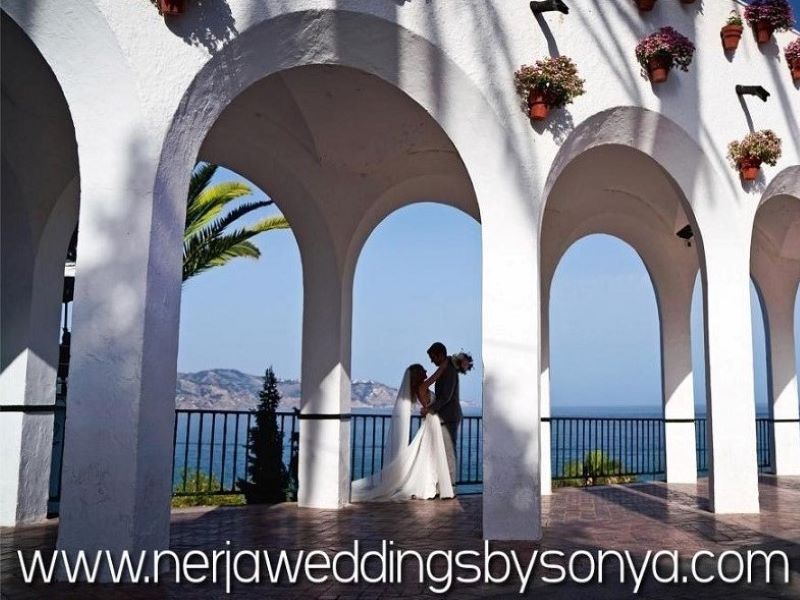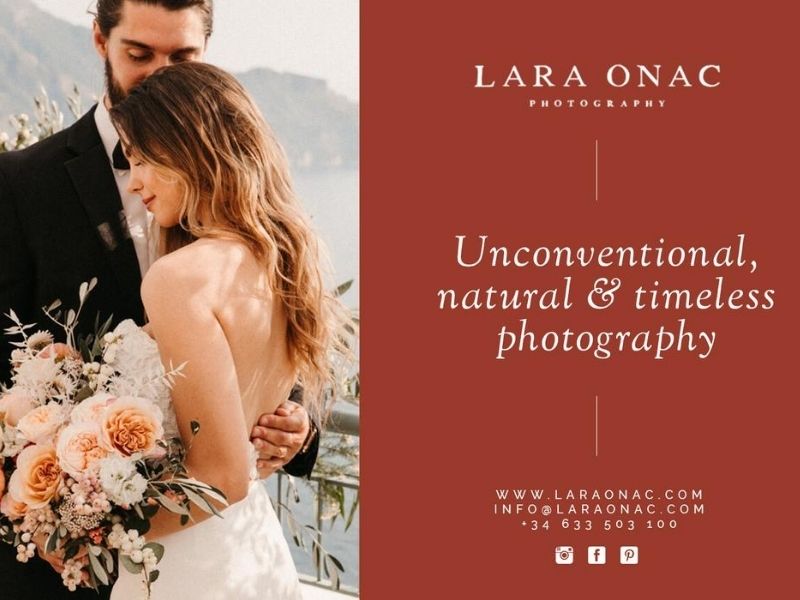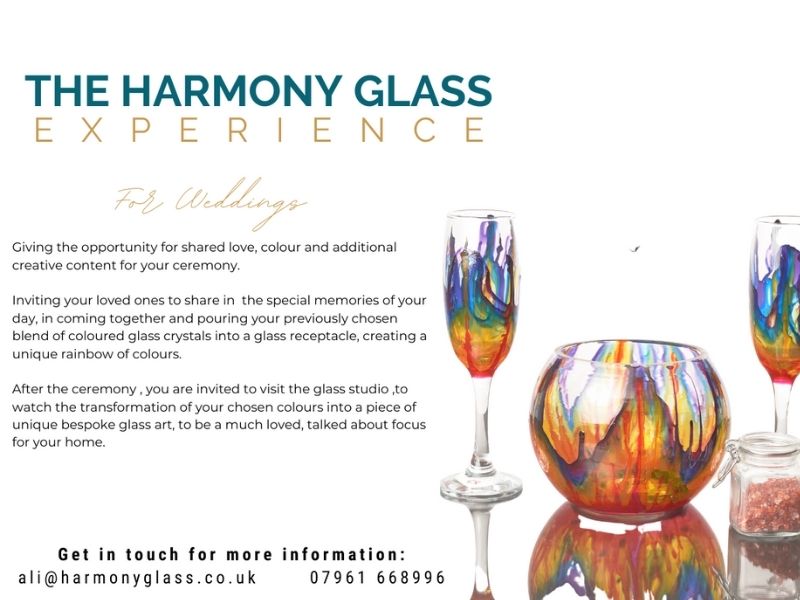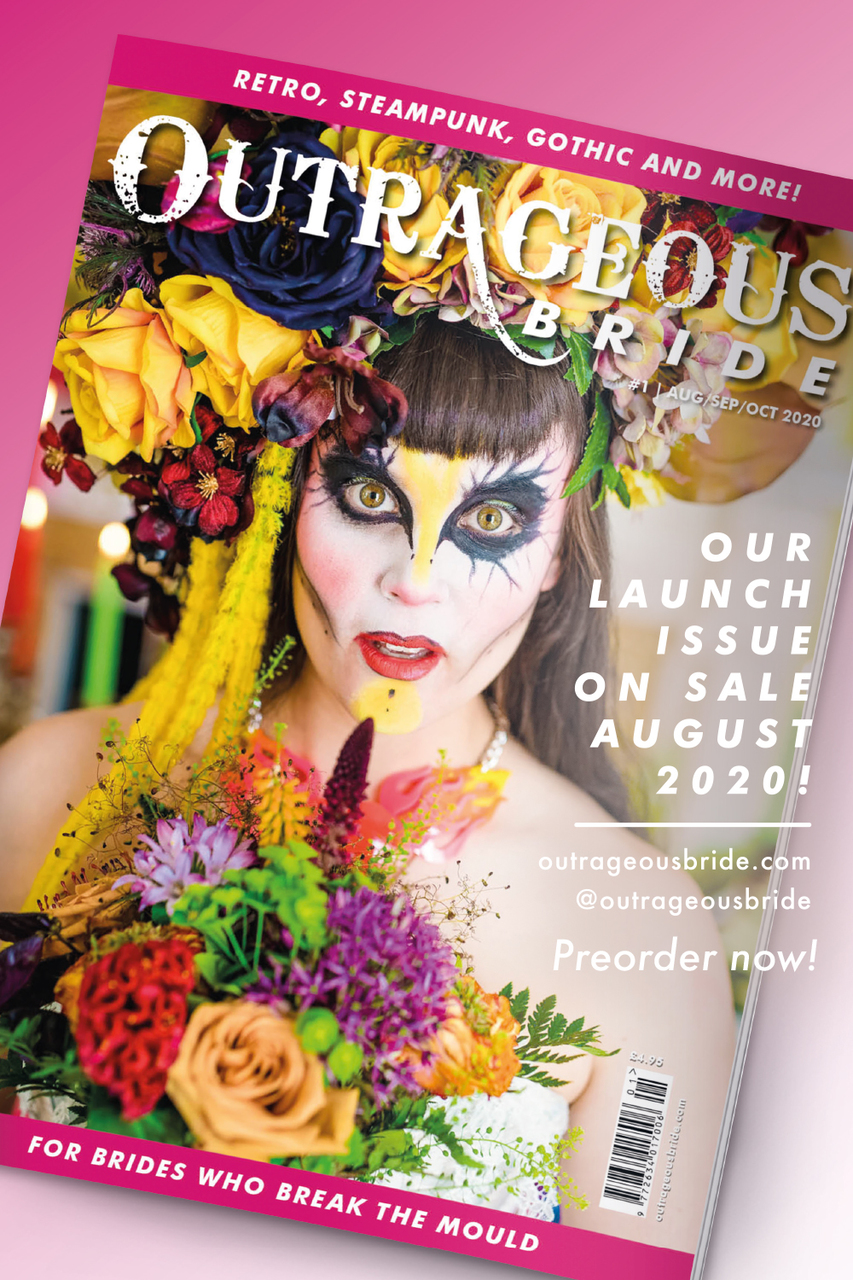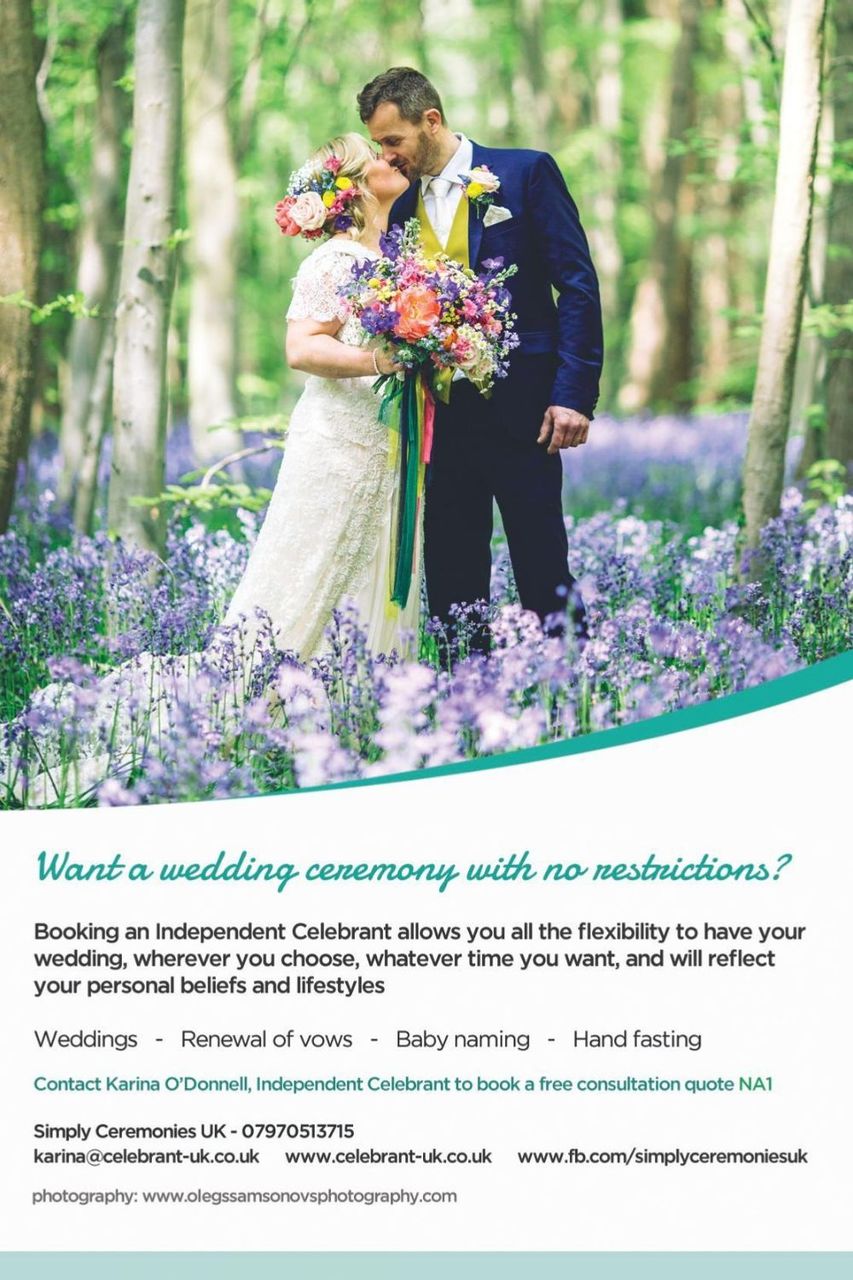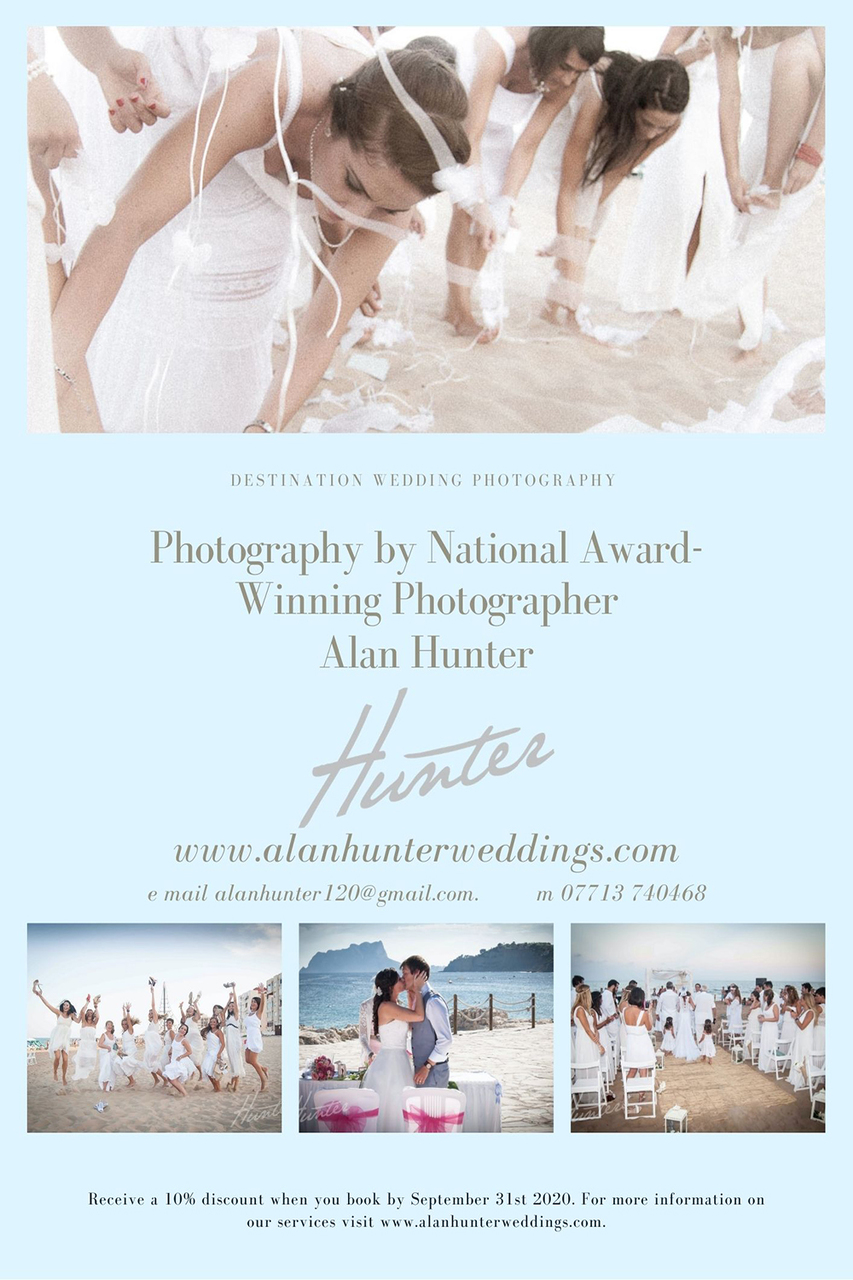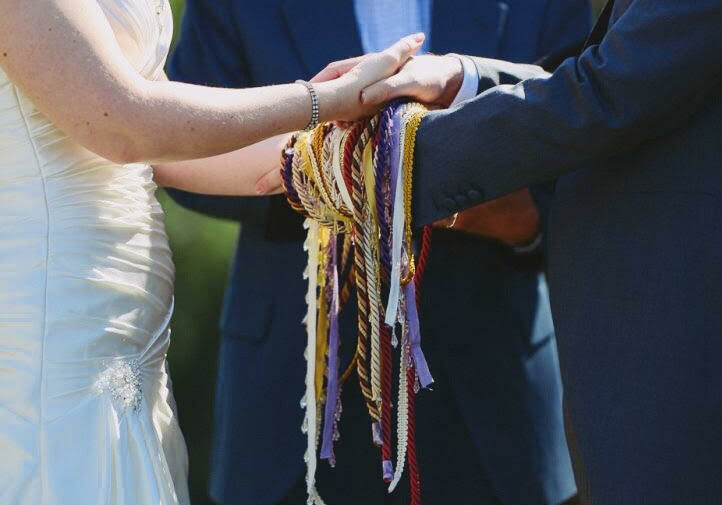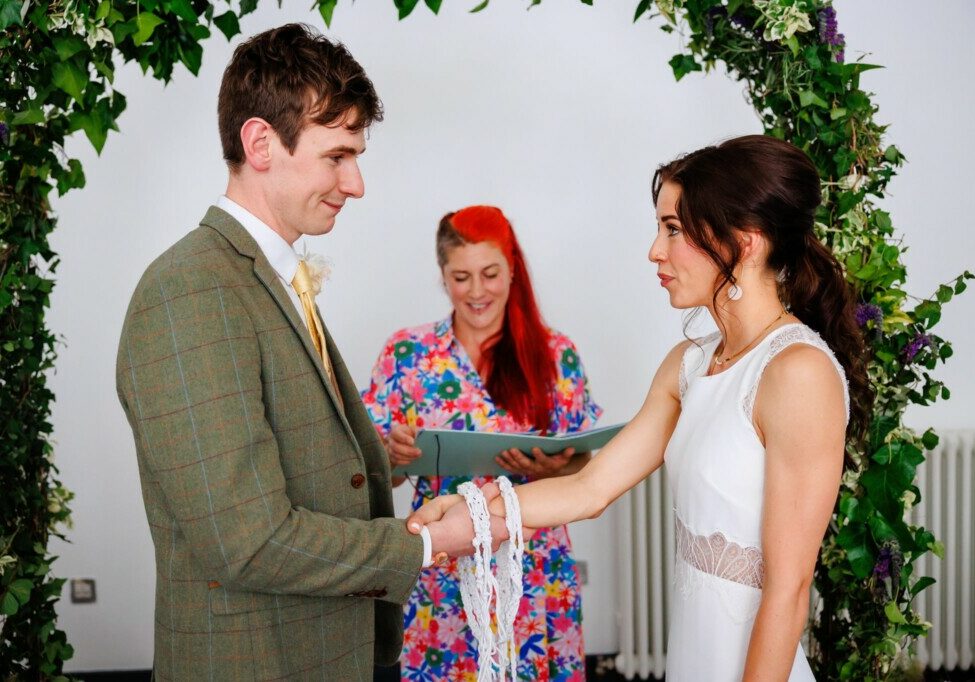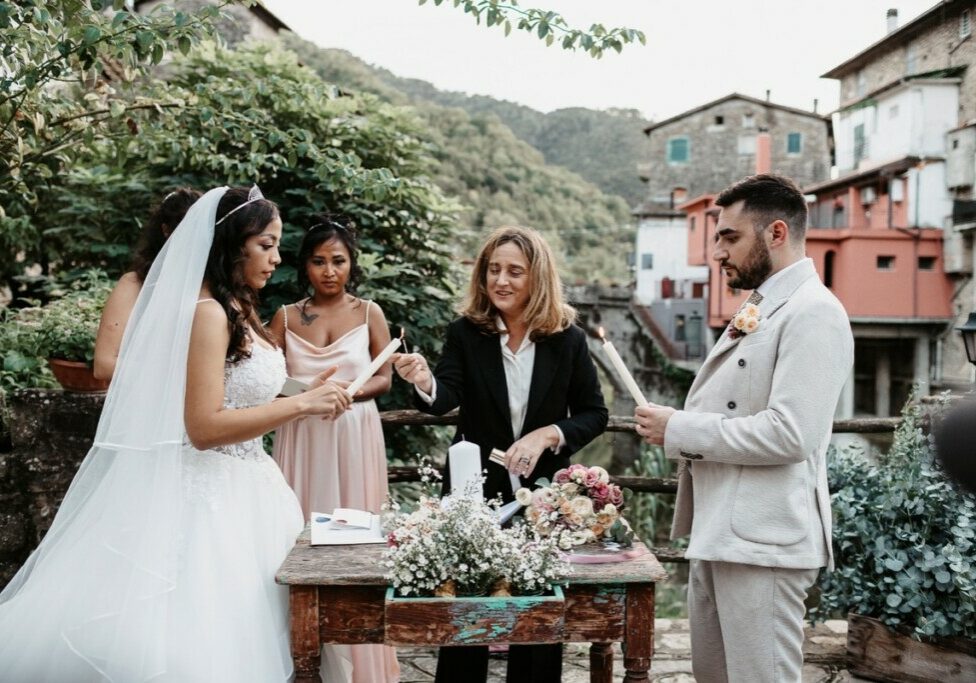The Art of Handfasting: A complete guide to handfasting ceremonies
posted inWeddings, Ceremony Inspiration
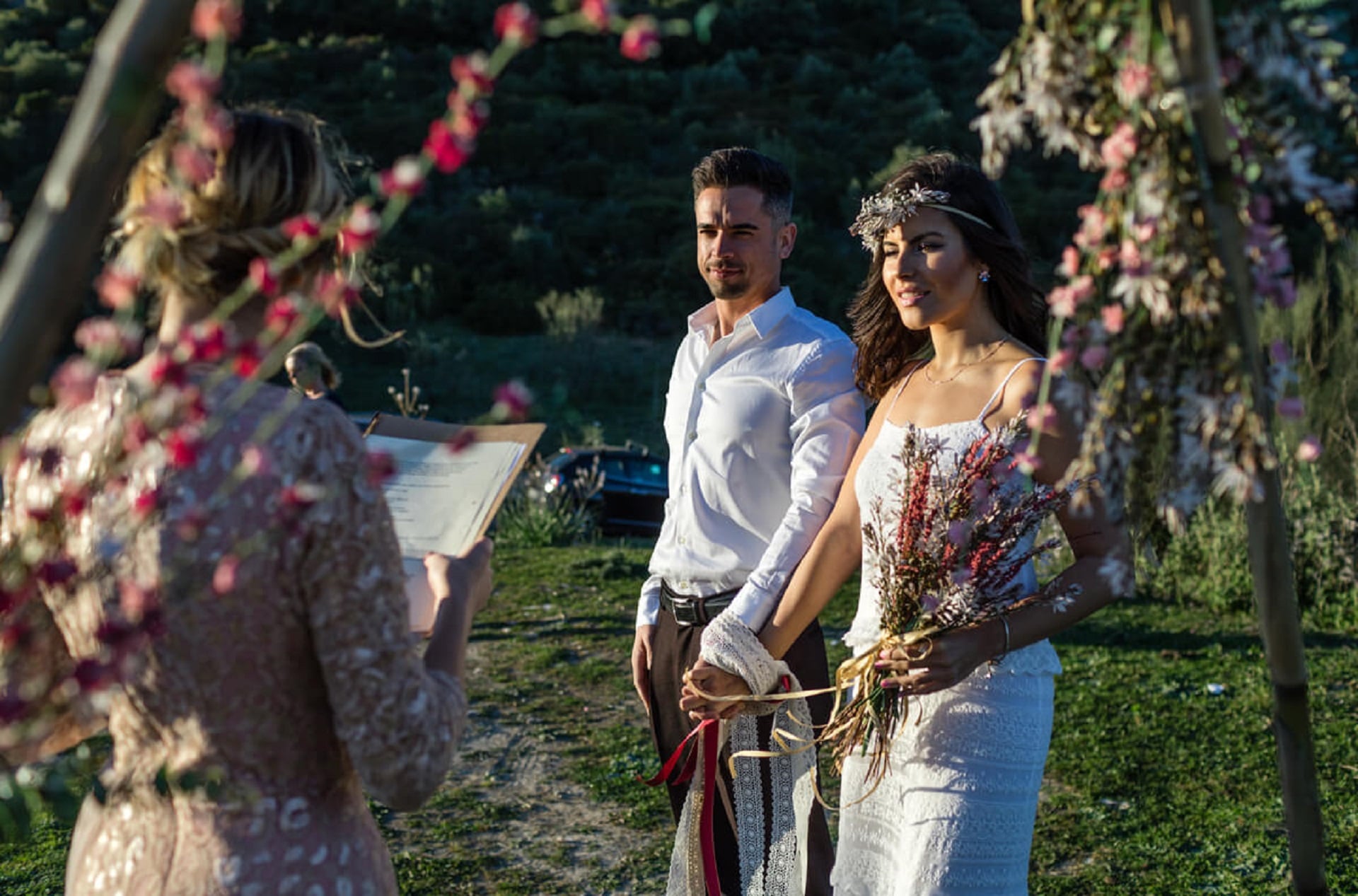
In the tapestry of wedding traditions, few threads shimmer with such ancient magic as handfasting. This captivating ritual, with its roots in Celtic and pagan customs, transcends mere ceremony. It’s a vibrant tapestry woven from history, symbolism, and profound love, finding renewed relevance in modern wedding celebrations.
Whether you dream of a classic ceremony or a whimsical elopement, handfasting offers a way to bind your love story with an enduring thread, forever etched in the memory of yourselves and your guests. Let’s delve into the art of handfasting, exploring its history, significance, and how you can weave it into your own modern fairytale.
What is Handfasting?
Handfasting is a beautiful, symbolic marriage ceremony or ritual and is believed to span several cultures dating back thousands of years. However, it is widely accepted as being of ancient Celtic origin and a nature-related ritual with a spiritual tradition. The phrase ‘tying the knot!’ and the action of shaking someone’s hand to agree on something are probably derived from this action of binding the couple’s hands together, often with coloured ribbons or cords to symbolise their union of love.
Beautiful words are spoken by the Wedding Celebrant before, during and after the ceremony which adds real romance and significance, making it very special!
Hands can be joined by crossing them or side by side and the ceremony is used by all types of couples as a lovely addition to their modern Celebrant led wedding ceremony, irrespective of religious belief or cultural traditions.
The History and Significance of Handfasting
The true origin of handfasting is not known, but the typical modern handfasting ceremony is derived from the Celtic tradition predating Christianity. It is a historical term for the word wedding, and as couples in Celtic England could not wander down the high street to buy a gold ring, they used handfasting as their marriage ceremony. Gold bands were also the preserve of the aristocracy, so the relatively simple but highly symbolic ritual of handfasting was much more affordable.
This symbolic binding of hands represented not just a legal union but the intertwining of souls, destinies, and the very fabric of the community. It was more than a promise; it was a woven knot of commitment, tested by a year and a day before deciding on permanent vows.
Couples would pledge their intent and love by binding their wrists with strips of fabric torn from old garments, or cord from rope to symbolise their union and would then be tied till midnight. They would often then be escorted to the bed chamber to consummate their union. This part of the ceremony is clearly not necessary in the 21st century, and you won’t find any modern-day celebrants carrying out this duty!
It was considered that if the couple survived the obstacles of life for the rest of the day, then surely they would survive marriage together. In the Scottish Celtic tradition, the binding would last for a year and a day, and if after that they still wanted to stay together, the handfasting was formally recognised as their wedding ceremony.
Though often associated with pagan traditions, handfasting’s essence endured, even weaving its magic into Christian wedding ceremonies. Today, its resurgence speaks volumes about couples seeking personalized, meaningful rituals that express their unique love stories.
Are Handfasting ceremonies popular?
Handfasting has become increasingly popular in recent years as people have moved away from traditional church weddings and cookie-cutter registry office affairs. Alongside the rise of the personalised celebrant-led wedding, there’s been a rise in demand for ceremonies with meaningful union rituals.
Handfasting in modern times can be celebrated and more importantly performed in several different styles in any location.
The popularity of Handfasting has been brought to the forefront of public knowledge due to its depiction on TV and in films. The 1995 film, ‘Braveheart’ shows William Wallace, played by Mel Gibson and Murron, the love of his life, being joined in a union of love in a Handfasting ceremony. Games of Thrones has also shown wedding scenes that include Handfasting and quite recently a major British soap held a Handfasting between two key characters.
With the growth and popularity of festivals, including Glastonbury, many couples are creating WEDFESTS or LOVEFESTS in fields and woodlands or forests and private grounds to celebrate their love.
Choosing to combine both traditional and ancient ceremonies is a great option for many couples torn between the two. After all, so much of the tradition of Handfasting is steeped in folklore and legend and open to modern interpretations.
Use our directory to Find a Celebrant who specialises in Handfasting.
What happens at a handfasting ceremony
In a traditional Pagan Handfasting ceremony, the handfasting is a complete ritual of not just the tying of hands, but the drawing of the blessings of deities or earth entities.
The area is blessed and made sacred. It may include the act of toasting and drinking from a loving cup and eating celebratory cake. The ceremony might also include a Sword and Chalice ritual or Oath Stone ceremony. These full Handfasting Ceremonies are meaningful and spiritual, performed by a celebrant with purpose and intent, going within, to draw on their own spirituality.
During the handfast, the couple will have their hands tied together with ribbons or cords, symbolising their union, binding them into their new future as one. Different knots or ties can be used, ranging from simple drapes to intricate bows and weaves.
The styles of Handfasting vary from the simple inclusion of the tying of hands within a traditional wedding ceremony to a Handfasting held in a sacred site such as stone circles such as Stonehenge or Avebury Circle.
Modern handfasting ceremonies often don’t include the associated pagan ceremony are actually handtying rituals and we’ll explore those in more detail later.
What are the four elements of handfasting
You might have heard people refer to the four elements of handfasting. The four elements, refer to the elements of Earth, Wind, Fire, & Water, which are symbolic in Pagan tradition and form part of the handfasting ritual prior to the hand-tying.
The four elements are “called in” by the High Priest or Priestess (or the person conducting the ceremony). There are several ways to call the corners, also known as ‘calling the four directions,’ ‘calling the quarters,’ or ‘calling the elements.’ All of these names refer to the same thing – calling upon the spirits and gods of the natural world to ask for their presence, aid, and blessing in ritual.
Items are often placed on the ceremonial altar to represent the 4 elements, such as:
- Earth- rock/stone or soil
- Wind – wind chime, feather, incense
- Water – cup or bowl of water, seashell or even a mirror
- Fire – candle or image of a flame
The inclusion of the four elements is typical in traditional pagan ceremonies but far less common in modern handfasting ceremonies; where they’re often not included.
Use our directory to Find a Celebrant who specialises in Handfasting.
Modern Handfasting Ceremonies
Modern Handfasting ceremonies, performed by celebrants, have been growing in popularity in the wedding industry. The modern version of this ancient ritual is becoming increasingly popular among couples looking for a unique and meaningful way to exchange vows and symbolize their commitment to one another.
Modern handfasting ceremonies are a contemporary take on the traditional handfasting ceremony, often blending the hand-tying ritual with other union rituals and customs adding a touch of modernity to the sacred act of joining two individuals in marriage.
Modern Handfasting ceremonies offer a personalised and inclusive alternative to traditional wedding ceremonies, allowing couples to incorporate their own beliefs, values, and cultural backgrounds through bespoke blessings, readings and declarations.
Real Wedding Inspiration: Raj & Joe Handfasting Ceremony
The Role of the Celebrant in Handfasting
Choosing the right celebrant is essential to creating the personalised ceremony you desire. A skilled celebrant will not only officiate the ceremony but also act as a co-creator, guiding you in crafting a ritual that reflects your unique story.
Your celebrant is responsible for leading the ceremony, joining your hands and tying your handfasting knots. Through their words, readings and blessings, they’ll weave your hopes, dreams, and shared passions into the fabric of the ceremony, imbuing it with warmth, personality, and lasting meaning.
If you want a traditional, full handfasting ritual according to Pagan traditions it’s important to choose your Celebrant accordingly. Whilst you’ll find many celebrants that offer handfasting ceremonies, there are Pagan celebrants, high priests and priestesses who practice and honour pagan traditions.
Who Can Conduct a Handfasting?
The spiritual beliefs and cultural and social background of each couple will generally determine the style of Handfasting conducted and the component parts that are included. Finding a celebrant who can perform a Handfasting in the style a couple seek is paramount. I suggest they speak with them in person, ask lots of questions and then make their choice.
Handfasting is a beautiful loving gesture and offers a very visual addition to the ceremony with a physical reminder in the form of the bindings. It is a very symbolic way to remember it and ‘ties the knot’, binding you in love to one another, in front of all of your loved ones. Creative and memorable keepsakes can also be part of the ceremony such as a signed commemorative certificate as proof that you have partaken in an ancient medieval Celtic Handfasting.
Use our directory to Find a Celebrant who specialises in Handfasting.
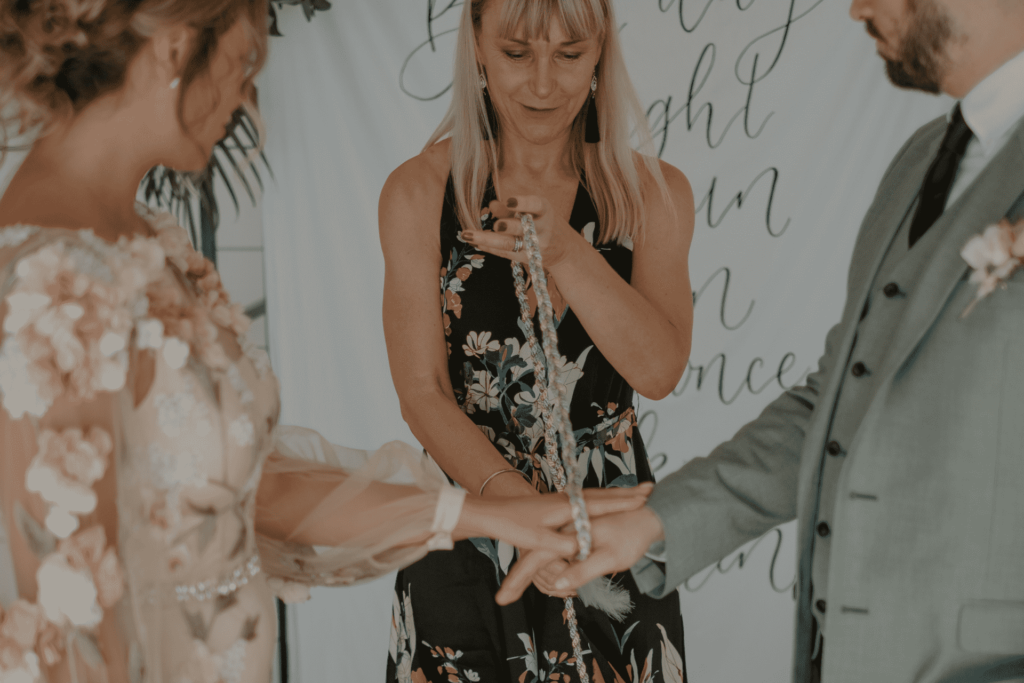
Different types of Handfasting Knots
From a simple wrapping of the hands, standing side by side and facing the world together, or even recognising the gift of your love with your hands layered and wrapped in a gift bow, there are different knots to include in your handfasting ceremony.
Some of the most common wraps are:
- “The Gift” Handfasting knot
- “The Infinity” Handfasting knot
- “The Drape” Handfasting knot
- “The Wrap” Handfasting knot
- “The Wrap, Release and Pull” Handfasting knot
- “The Loose” Handfasting knot
- “The Discrete” Handfasting knot
- “Side by Side” Handfasting knot
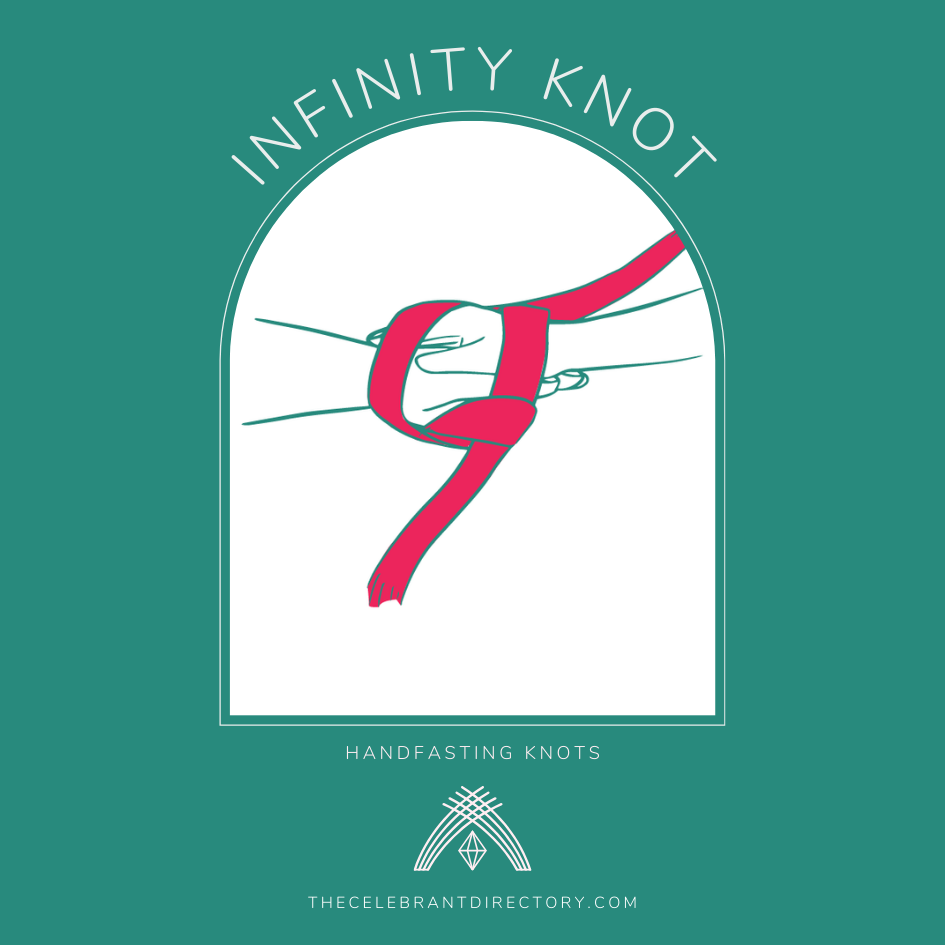
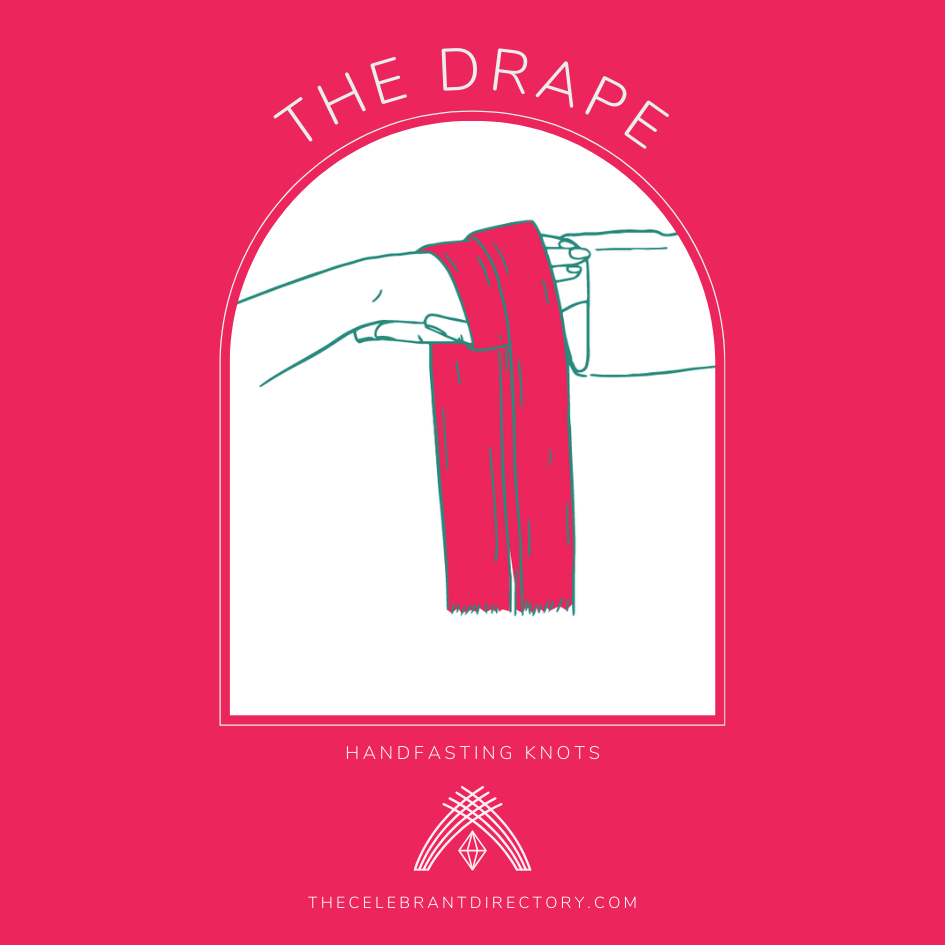
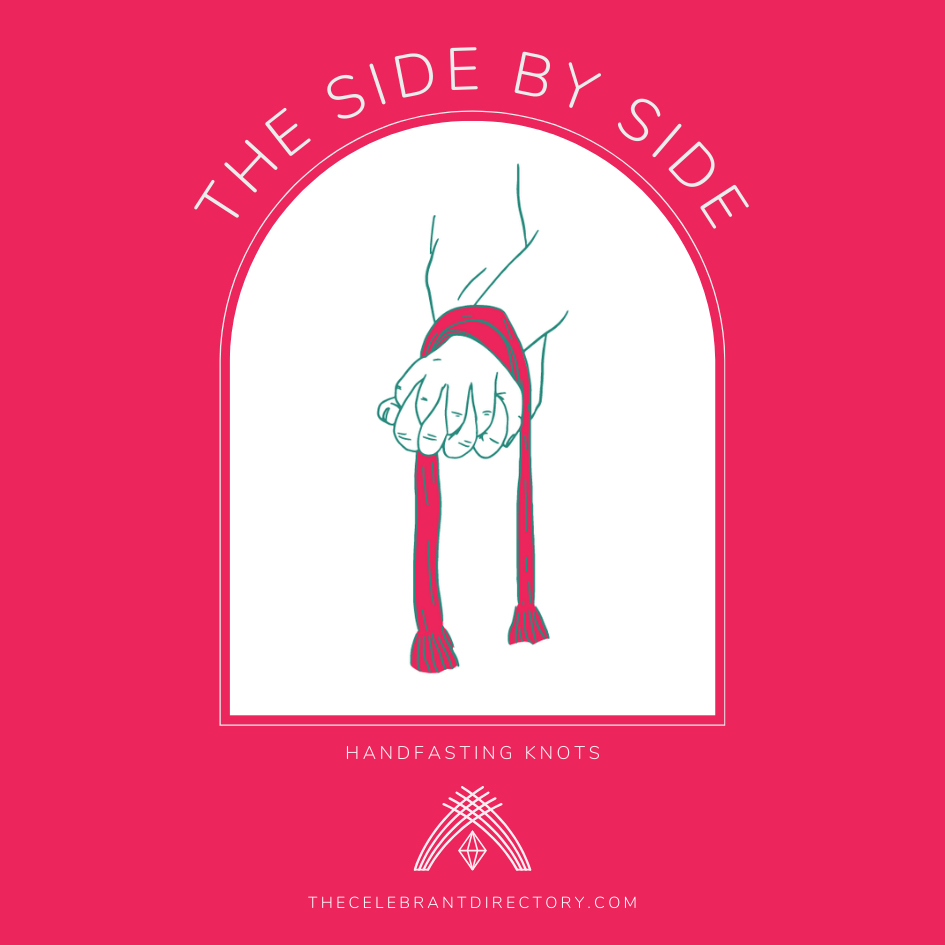

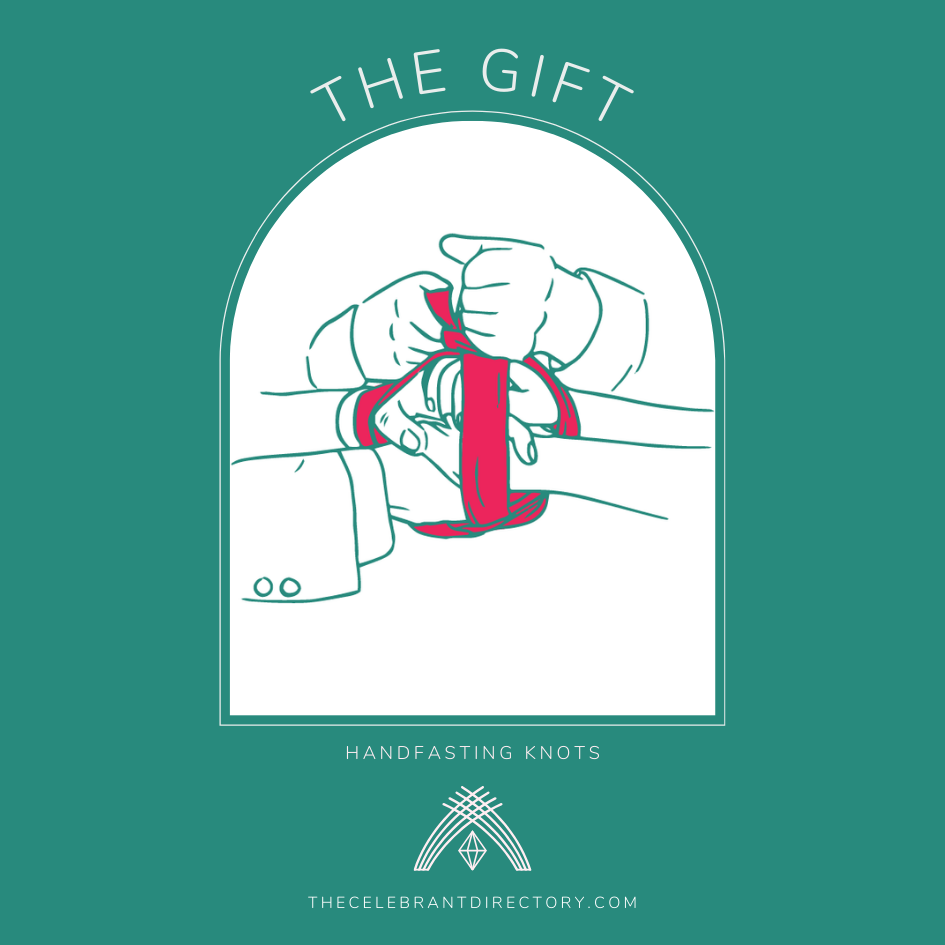
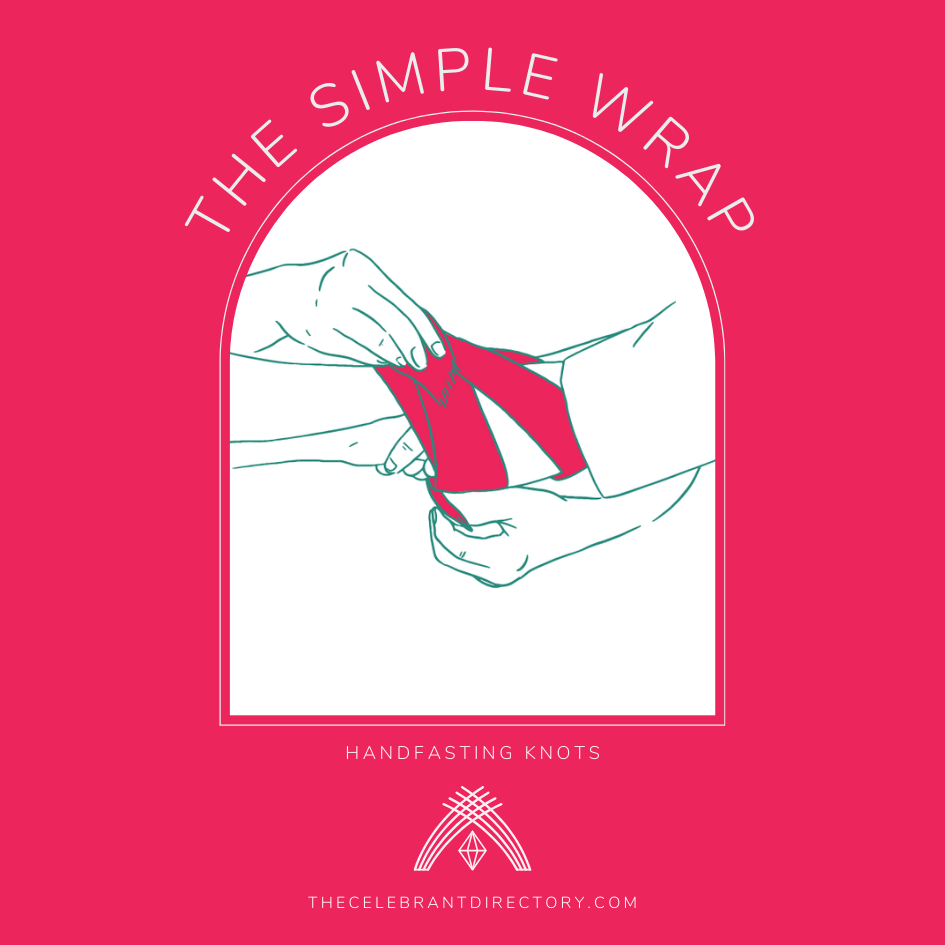
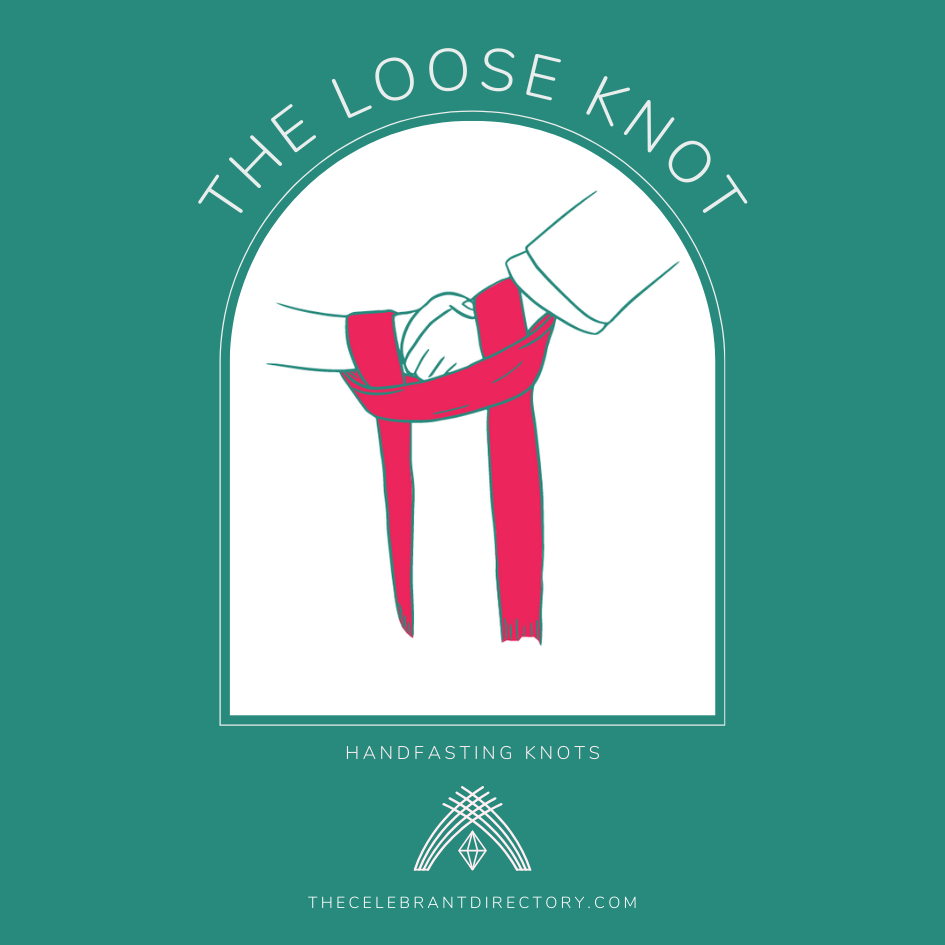
Here, Jane Bechtel shows us how each knot looks (and how to do it!).
Not every Celebrant is experienced in Handfasting – it’s important that you chat to them about your expectations for the Ceremony to make sure they are the right person for the job.
How many cords are in a Handfasting ceremony?
There is no set rule for how many cords you can use in a Handfasting ceremony; however, three is the most popular amount, as it allows the couple to braid the cords together.
If you choose to use just one cord, it is recommended that you choose a fabric that is a minimum of one to two metres long so that it can loop around your hands and wrists.
What do the colours of Handfasting cords mean?
The colours you choose for your Handfasting ceremony reveal a huge deal about you as a couple; you can use the colours to add another poignant layer to the ceremony.
Some different ways you can use colour in the ribbons and cords of your handfasting include:
- Your past, present and future – every colour or fabric will represent a different period
- Your dreams, hopes and adventures as a couple
- Special people in your life – for example, if you have children they could be symbolised with one colour, your parents with another and so on
- Your personalities – you could have a yellow ribbon to express the joy in your partnership, a red for the passion, blue for the deep, thoughtful emotions
- Any promises that you are making for your marriage, such as gold for success or green for exploring the natural world as one
- Any faith communities that you hold dearly
- … or it could even just be in line with your wedding colour scheme!
Another huge benefit of tapping into the different colours and fabrics of your Handfasting is that this can then be used as inspiration for your vows or promises to one another, bringing the entire ceremony together seamlessly.
Find out more about the meaning and symbolism of handfasting cord colours
Planning Your Handfasting Ceremony
Now, let’s turn to the practical magic of crafting your own handfasting experience. The heart of the ritual lies in the cord, a tangible symbol of your bond. Whether you choose a silk ribbon woven with personal intentions, a rustic hemp cord echoing ancestral ties, or a vibrant braid infused with the colours of your love story, ensure it resonates with your hearts.
Personalization is the lifeblood of a handfasting ceremony. Perhaps you whisper vows under a full moon, weave threads representing shared passions, or incorporate cherished family heirlooms as blessings. Remember, there are no set rules, just endless possibilities to weave your narrative.
Choosing the right celebrant or officiant is crucial. Seek someone who resonates with your values, understands the spirit of handfasting, and can guide you in crafting a ceremony that speaks your truth.
Use our directory to Find a Celebrant who specialises in Handfasting.
Incorporating Handfasting into different wedding styles
The beauty of handfasting lies in its adaptability. It seamlessly blends with the classic elegance of a traditional ceremony, adding a touch of ancient mysticism. Imagine vows exchanged beneath a canopy of wildflowers, the handfasting cord echoing the ivory of your gown and the emerald of the surrounding hills.
For themed weddings, handfasting offers an opportunity to weave cultural or historical threads into your narrative. Picture a Viking-inspired ceremony, the cord braided with leather and adorned with runes, echoing the strength and loyalty of your bond. Or perhaps a Celtic elopement, where the wind whispers blessings as you bind your hands amidst ancient stone circles.
Even intimate ceremonies gain depth with handfasting. Imagine exchanging vows by a crackling fire, the handfasting cord a beacon of warmth and promise as you face the world together, hand in hand.
How Can We Personalise a Handfasting Ceremony?
As with all ceremonies, couples can choose beautiful traditional Celtic readings and have music played on lute, harp or drum. The couple set the tone and mood of their ceremony by the choices they make. Handfasting can be created to be both sincere and reverent, nature-related and spiritual, as well as fun and inclusive. Guests can end the ceremony by counting the couple down to jumping over the besom broom. Culminating in the throwing of rose petals or breadcrumbs.
Handfasting has changed since its original inception, and today couples are being creative and imaginative in where and how they prepare and decorate the space for the ceremony. Much imagination can also be used in representing earth’s four elements. Some couples ‘go large’ and have a real fire pit and wind chime in the trees. Others rely on my elemental table where a candle burns and feathers or a bell represent air.
Couples selecting their Celebrant should be supported throughout the creating of their Handfasting. They should ideally be sent choices of suitable readings, vows, pledges and words of endearment to create the love, warmth and energy of their Handfasting.
If you think a Handfasting is for you then set about planning yours. Be creative. Be imaginative. Be inspiring. Be yourselves!
Find your perfect Celebrant for your Handfasting ceremony by browsing our Celebrant Directory.
Handfasting rituals and variations
The handfasting ritual itself is a beautiful tapestry of words and gestures. The officiant might explain the history and symbolism of the ritual, invoking blessings upon your union. Then, the moment arrives – the joining of hands. With each gentle loop of the cord, promises are spoken, destinies intertwined, and love made tangible.
With so many variations and endless possibilities to combine other union rituals from around the world, blessings, readings and even songs to enrich the ceremony, a handfasting ritual is a beautiful way to create a memorable wedding ceremony.
You can even weave meaning into the way the handfasting knot is tied: Celtic traditions favour three loops, each representing past, present, and future. Other cultures might use intricate knots, each symbolizing different aspects of your bond. Whether you choose a simple bind or a complex weave, let your hands tell the story of your love.
Handfasting Ceremony Script.
The beauty of a Handfasting ceremony – especially when it is led by a Celebrant – is that it gives you the space and freedom to layout your wedding however you please.
But if you’re looking for some inspiration, here is an example script for how to structure your Handfasting wedding ceremony.
- Processional and music
- Welcome and Statement of Intention
- First Reading
- Second Reading
- Presentation of the Handfasting cords or ribbons
- Handfasting ritual
- Exchange of Vows
- Declaration of Marriage
- Closing
- Recessional and music
Are There Any Other Traditions That Go Alongside a Handfasting?
Following the binding and tying of the hands, the couple may choose to partake in ‘Cake and Ale’ with a ceremony to toast their health and happiness and to symbolize the beginning of their life together. Traditionally, ale was drunk, but this can be any beverage of choice. Some couples drink cider, beer, wine, mead, well water and cold tea! A special two-handled Scottish quaich or loving cup is traditionally used, but also goblets and animal horns have been presented to me. The cake can vary too, from individual cupcakes to larger cakes being cut and shared with guests.
A Handfasting ceremony may also have a traditional ‘Jumping a besom broom’ ceremony to signify the creation of a hearth and home together. The tradition of jumping the broom has long been associated with marriage and cohabitation in not only Europe but Africa and America. Couples have also made their own besom broom.
Celebrant and Photographer Credit: Deborah Page, Glenda Procter and Ben Birchall/PA Wire.
Originally published 19.11.19, inspired by Glenda Procter’s knowledge of handfasting and hand-tying, updated March 2024.
Find a Handfasting Celebrant
If you want to incorporate a handfasting ritual into your ceremony, search today and find your perfect Celebrant for your Handfasting ceremony by browsing our Celebrant Directory.
subscribe
drop us your email and we'll send you beautiful ideas to inspire your perfect celebration
